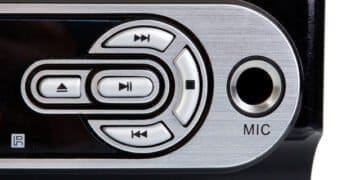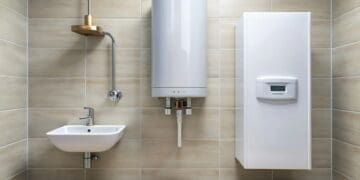In the modern era, home automation controllers have revolutionized the way we live, transforming ordinary households into smart havens of convenience and efficiency.
These innovative devices act as the brain behind seamless home automation systems, allowing you to control various aspects of your home with just a touch of a button or voice command.
From lighting and climate control to security and entertainment, home automation controllers seamlessly integrate and orchestrate a wide range of smart devices and sensors, enabling you to automate tasks and create personalized scenes tailored to your daily routines.
Whether you’re aiming to enhance energy efficiency, bolster home security, or simply elevate your overall living experience, understanding the capabilities of home automation controllers is the first step towards redefining smart living.
Understanding the Wireless Home Automation Controller Hardware

At the heart of any wireless home automation system lies the controller hardware, which serves as the central command center for orchestrating and managing various smart devices and sensors throughout your home.
This crucial component consists of three primary elements: sensors, actuators, and controllers.
Sensors
Sensors are devices that detect and monitor various environmental conditions or events within your home.
They gather data and relay it to the controller, enabling it to make informed decisions and trigger appropriate actions.
Examples of sensors include motion detectors, temperature sensors, door/window sensors, and smoke detectors.
Actuators
Actuators are the components responsible for executing commands received from the controller.
They are essentially motors, switches, or valves embedded within smart devices that control specific functions.
For instance, the motor found inside a motorized smart lock is an actuator that physically locks or unlocks the door based on the controller’s instructions.
Controllers
Controllers are the intelligent devices, such as tablets, smartphones, or dedicated home automation hubs, that serve as the brain of the system.
They receive input from sensors, process the data, and send commands to actuators to perform desired actions.
Controllers are equipped with software or applications that allow you to monitor and control various aspects of your home automation system.
Wireless home automation systems typically rely on various communication protocols to facilitate seamless connectivity between devices. Some of the most common protocols include:
- Wi-Fi: Wi-Fi is the most widely used protocol, allowing IoT devices to connect to the internet and communicate with each other through your home’s existing wireless network.
- Z-Wave: Z-Wave is a wireless mesh network technology that operates on a low-power frequency, ensuring reliable communication without interfering with your Wi-Fi network.
- ZigBee: Similar to Z-Wave, ZigBee is a mesh network protocol that enables low-power, secure communication between IoT devices.
- Bluetooth: Bluetooth technology is another option for connecting and controlling IoT devices within a limited range, often used for personal area networks.
- Thread: Thread is an IP-based mesh networking protocol designed specifically for low-power IoT devices, providing a secure and reliable communication platform.
When choosing a home automation controller, it’s essential to consider the communication protocols supported by the devices you plan to integrate into your system.
Key Components of a Wireless Home Automation System

Sensors
Sensors are crucial components that act as the eyes and ears of a wireless home automation system.
They continuously monitor various environmental conditions and events within the home, gathering data and relaying it to the controller. Some common types of sensors include:
- Temperature sensors for climate control and maintaining desired comfort levels.
- Moisture sensors to detect leaks and prevent water damage.
- Motion detectors for security purposes and automating lighting based on occupancy.
- Door/window sensors to detect when doors or windows are opened or closed, enhancing home security.
- Smoke detectors and carbon monoxide sensors for safety monitoring.
Controllers
Controllers serve as the brain of the wireless home automation system, receiving input from sensors, processing data, and sending commands to actuators to perform desired actions. They can take various forms, such as:
- Tablets
- Smartphones
- Dedicated home automation hubs
Controllers are equipped with software or applications that allow users to monitor and control various aspects of their home automation system, providing a centralized interface for managing all connected devices and settings.
Actuators
Actuators are the components responsible for executing the commands received from the controllers. They are essentially motors, switches, or valves embedded within smart devices that control specific functions. Examples of actuators include:
- Motors in motorized smart locks for locking and unlocking doors.
- Switches in smart lighting systems for turning lights on or off and adjusting brightness levels.
- Valves in smart irrigation systems for controlling water flow to sprinklers or drip lines.
Setting Up the Wireless Controller

The central hub or controller acts as the brain of the home automation system, connecting to all the smart devices in your home and allowing for seamless communication and control. To set up your wireless controller, follow these steps:
Selecting the Central Hub
- Choose a central hub or controller to serve as the command center for managing and controlling all connected devices from a single interface.
- Ensure the hub is compatible with a wide range of devices and protocols like Wi-Fi, Bluetooth, Zigbee, Z-Wave, or Matter to future-proof your system and enable seamless communication with your smart devices.
Initial Setup
- Most smart devices connect to a smartphone, tablet, or laptop for initial setup and configuration. Follow the setup guide provided with each device, which typically directs you to download the companion app as the first step.
- During the setup process, you may need to scan a QR code or enter a serial number found on the device or in the instruction booklet.
- The setup process may also involve linking the device to your chosen ecosystem (e.g., Apple Home, Google Home, or Amazon Alexa) by manually linking your account or installing the relevant skill.
Connecting Devices
- Some devices rely on wireless protocols like Zigbee and Z-Wave to communicate with the hub, consolidating all your smart home products under one app for centralized control.
- Other devices can be controlled directly via Wi-Fi and their companion mobile apps, without requiring a hub.
- Start with one or two gadgets first, as building a smart home with multiple ecosystems can feel overwhelming. Break down the process into smaller steps for better manageability.
Configuration and Customization
- After setting up devices and linking them to your chosen ecosystem, you may need to access the third-party app to configure particular settings or access advanced features.
- The central hub or ecosystem app (e.g., Apple Home, Google Home, Alexa) typically offers a simplified set of controls for most devices, but the third-party app may be required for specific customizations.
- Once the initial configuration is complete, you can adjust the systems as necessary to enjoy the benefits of a fully automated and personalized smart home experience.
By following these steps, you can seamlessly set up your wireless home automation controller, connect various smart devices, and customize the system to suit your preferences and daily routines.
Connecting Smart Devices and Sensors
Establishing Seamless Connectivity
To unlock the full potential of a wireless home automation system, seamless connectivity between various smart devices and sensors is paramount. The key to achieving this lies in understanding and leveraging the appropriate communication protocols and standards.
- Wireless Communication Protocols: Most smart devices can connect via Bluetooth, Wi-Fi, or dedicated smart hubs that use low-power, long-range technologies like Zigbee, Z-Wave, or Thread. While Wi-Fi might seem like the easiest solution, a dedicated smart hub can help reduce network congestion, offer better stability, and enhance responsiveness.
- Ecosystem Compatibility: Look for logos on product packaging or websites that indicate compatibility with popular ecosystems like “Works with the Google Assistant,” “Works with Alexa,” or “Works with Apple HomeKit.” These logos ensure a basic level of support, allowing you to connect and control devices using voice commands. However, the extent of functionality may vary between products, so it’s essential to check user reviews or command lists for a complete picture.
- Voice Assistant Integration: Some smart home devices come with built-in voice assistants like Alexa or Google Assistant, allowing you to control them directly using voice commands. Devices with this feature typically display logos like “Alexa built-in” or “Google Assistant.”
- Wireless Standards: Different wireless standards like ZigBee, Z-Wave, and Thread connect smart home devices behind the scenes. While these technologies don’t typically matter to end-users, the lack of common standards has hindered the smart home scene for years.
- Matter Standard: Matter is a new wireless interoperability standard aimed at enabling seamless communication and secure connectivity between smart home devices, regardless of the underlying technology or ecosystem. With Matter, devices from different manufacturers and ecosystems can work together seamlessly, simplifying setup and ensuring compatibility.
Integrating Smart Devices and Sensors
Once you’ve established a robust wireless home automation system, it’s time to integrate various smart devices and sensors to unlock the full potential of automation. Here are some common smart devices that can be seamlessly connected to your home security system:
- Smart Doorbell Cameras: These devices allow you to see who’s outside before answering the door, set motion sensor alerts, view previous footage, and even communicate with visitors remotely.
- Smart Cameras: Indoor and outdoor smart cameras enable you to monitor your home from anywhere, check on your family or pets, and access live and recorded footage through your home security app. When paired with your home security system, you can set up motion sensor alerts and automatically turn on alarms and cameras from the same app.
- Smart Locks: Go keyless with smart locks, designed to enhance security and convenience. You can set up different entry codes for family members, track who’s coming and going, and remotely lock or unlock doors from your smartphone or voice commands.
- Smart Lights and Outlets: These devices allow you to conserve energy and control lights and outlets remotely, making it easier to turn devices on or off from anywhere, even when you’re away from home.
- Smart Thermostats: Save money on utility bills by controlling your home’s heating and cooling system from anywhere. You can set up smart thermostats to automatically adjust the temperature based on your presence or integrate them with other smart devices to create automated routines.
- Smart Smoke Detectors: Receive alerts if a smoke detector is triggered, whether you’re at home or not. These alarms can be programmed to turn on lights, allowing you to see in the middle of the night, and can be easily turned off from your app if accidentally set off.
- Smart Garage Door Openers: No more wondering if you shut the garage door – smart openers allow you to open or close your garage door from anywhere using your smartphone.
- Voice-Controlled Virtual Assistants: Pair your home security system with virtual assistants like Alexa or Google Assistant to control all your smart devices using voice commands and set up routines that initiate a series of automated actions with a single voice command.
By integrating these smart devices and sensors with your wireless home automation system, you can enhance convenience, security, energy efficiency, and overall home management, creating a truly personalized and automated living experience.
Maximizing Convenience and Accessibility
Integrating smart devices with voice control systems not only enhances convenience but also offers accessibility to those with mobility challenges.
As a professional integrator, mastering the art of connecting various devices to voice assistants is crucial, enabling homeowners to adjust lighting, control thermostats, lock doors, and even order groceries with simple voice commands.
To maximize convenience, consider building home automation systems that can function without the need to open an app. For example, Wi-Fi Sensing technology can sense when someone is in a room and automatically turn on lights, adjust energy and HVAC usage based on human presence, providing a truly seamless and hands-free experience.
Furthermore, ensure that all smart home technologies in the home can communicate seamlessly with each other.
As an integrator, it is essential to ensure that the devices you’re installing can interact and share data effortlessly, creating a cohesive and integrated system.
By prioritizing convenience and accessibility through voice control integration, hands-free automation, and seamless device communication, you can elevate the smart home experience for homeowners, making their lives more comfortable, efficient, and inclusive.
Programming Automation Rules and Scenes
Understanding Automation Rules
Automation rules are sets of instructions that tell smart devices what actions to perform when certain conditions are met.
For example, a rule can be created to turn on the lights when someone arrives home or lower the thermostat when the house is empty.
To create automation rules, the first step is to choose a platform that can control the smart devices.
This platform can be a software or hardware system that connects the devices and allows for creating rules and scenes.
A rule typically consists of three components:
- Trigger: An event that initiates the rule, such as a specific time, location, or device status change.
- Condition: A requirement that must be met for the rule to execute, like a temperature threshold, mode setting, or day of the week.
- Action: The command that the rule executes when the trigger and condition are satisfied, such as turning on a device, changing a setting, or sending a notification.
Creating Automation Scenes
In addition to rules, users can create scenes to control multiple devices simultaneously.
A scene is a preset combination of settings that can be activated with a single command, such as a button press, voice command, or rule.
To create a scene, users can follow these general steps:
- Select the devices to be included in the scene.
- Choose the desired settings for each device, such as light brightness, thermostat temperature, or door lock status.
- Save the scene with a descriptive name and assign it to a voice command or physical button for easy access.
Scenes can be triggered manually or automatically through rules, allowing users to create customized experiences tailored to their daily routines and preferences.
Testing and Troubleshooting
After creating automation rules and scenes, it is essential to test and troubleshoot them to ensure they work as intended and do not conflict with each other or cause unintended side effects.
This may involve monitoring the system, making adjustments, and resolving any issues that arise during the testing phase.
By following these steps, users can harness the power of automation rules and scenes to enhance the convenience, efficiency, and personalization of their smart home experience.
Integrating Voice Control and Smart Assistants
The Rise of Voice Control
The advent of virtual assistants like Apple’s Siri, Amazon’s Alexa, and Google Assistant formed the bedrock for a revolution in human-machine interaction. Smart home devices and ecosystems thus began integrating voice control features, enabling users to command lights, thermostats and even kitchen appliances with the spoken word.
This transition marked a departure from traditional interfaces like remote controls and touchscreens, offering a more intuitive and hands-free experience.
Early implementations of voice activation were rudimentary, but even then, there were hints of the immense potential held by the technology.
In the beginning, users could get answers to simple questions, set timers, and play music, but the promise of a seamlessly integrated and adaptive smart home was waiting on the horizon.
The gradual expansion of voice recognition vocabulary and the ability of contextual comprehension paved the way for more intricate and complex voice commands.
Embracing Voice Assistants
Thanks to the availability of a wide variety of voice-controllable devices — interactive voice assistants and smart speakers from Josh.ai, Apple, Amazon, and Google, for instance — controlling your home while being completely hands-free is not just possible but really, quite enjoyable (insider’s tip: changing the voice is possible with some voice assistants and smart speakers, which ups the fun factor significantly).
Bottom line; it’s become increasingly popular for people to use voice assistant technologies over traditional user interfaces like keypads, touch panels, smartphones and remote controls as the preferred method of controlling smart devices in a home.
We’ve reached the point now where voice control has been embraced by all ages and genders for its simplicity and is recognized as a solution for those with poor vision, mobility, or simply a fear of technology.
Able to hear, understand, and execute verbal commands, voice control platforms have eliminated the need to tap buttons on a smartphone or tablet to retrieve music, find a keypad in the dark to turn on the lights, or type information with your remote control to find a particular movie to watch.
The hands-free nature of this voice control and voice-enabled technology interaction is the main reason homeowners have adopted voice control.
Voice Control Applications
Getting more specific, there are a wide variety of applications for which voice control is ideal. For example, it’s extremely helpful when your hands are occupied.
It’s also simpler and quicker to cue music, tune-in to a particular TV program or set thermostats to specific setpoints via a voice command than manually scrolling through menus on a touch panel or mobile app.
Despite all of its appeal, voice control isn’t the end-all-be-all of a smart home lifestyle.
There are still many occasions when using a keypad, touch panel, remote control, or smartphone makes more sense. By layering in other methods of control, home technology integrators are able to offer a fully robust solution, enabling homeowners to use voice control for certain situations, and keypads, touch panels, apps and remotes for other types of tasks.
Setting Up Voice Control
- Step 1: Choose Your Smart Home Platform
The first step is to select a smart home platform that supports voice control integration. Popular options include Amazon Alexa, Google Assistant, Apple HomeKit, and Samsung SmartThings. - Step 2: Get a Voice Assistant
The next step is to choose a voice assistant that you want to use to control your devices. The most popular voice assistants are Amazon Alexa, Google Assistant, and Apple’s Siri. Each assistant has its own unique features and compatibility with different devices, so it is important to research and select the one that best suits your needs. - Step 3: Connect Your Devices to Your Voice Assistant
Once you have selected a voice assistant, the next step is to connect your devices to it. This can be done through the use of smart plugs, smart hubs, or directly connecting the device to your voice assistant through its app or website. Be sure to follow the manufacturer’s instructions for connecting your devices to your voice assistant. Smart plugs and smart hubs act as a bridge between your voice assistant and your non-smart devices, allowing you to control them through your voice assistant. Many smart plugs and smart hubs also offer additional functionality such as energy monitoring and scheduling. - Step 4: Create Routines and Set Up Voice Commands
With your devices connected to your voice assistant, you can now create routines and set up voice commands. For example, you can create a routine for your lights to turn on when you say “Good morning” or set up a voice command to turn off your appliances when you say “Goodnight.” The more routines and commands you create, the more automated your home will become. - Step 5: Add Additional Features and Integrations
Voice assistants are constantly evolving and adding new features and integrations. Some examples include integrating with other smart home devices, such as security cameras and smart locks, as well as integrating with other services such as music streaming and news. For example, you can integrate your security cameras with your voice assistant and set up commands to view the camera feed, or to receive alerts when motion is detected. Similarly, you can integrate your voice assistant with a smart lock, allowing you to lock and unlock your doors with voice commands. Integrating with other services, such as music streaming and news, can also enhance the overall experience of your automated home. You can set up commands to play your favorite music or to receive the latest news headlines with a single voice command.
By following these steps, you can seamlessly integrate voice control and smart assistants into your home automation system, unlocking a world of hands-free convenience and personalized automation tailored to your daily routines and preferences.
Troubleshooting and Maintenance Tips
General Troubleshooting Tips
Like any other electronic device, home automation devices require regular maintenance to ensure optimal performance and longevity. Neglecting maintenance can lead to decreased efficiency, reliability issues, and even potential safety hazards.
If your home automation system isn’t working as expected, there are several troubleshooting steps you can take:
- Check Power and Connections: Ensure that all devices are properly powered on and that cables are securely connected. Loose or dislodged cables can cause intermittent issues or buzzing sounds.
- Restart Devices: Sometimes, a simple restart can resolve minor glitches or connectivity problems. Power cycle (turn off and on) the devices or unplug them for about 30 seconds before reconnecting.
- Check Network and Router: If your system relies on a wireless network, ensure that your router is functioning correctly and that all devices are connected to the same network.
- Update Firmware: Check for firmware updates regularly and install them promptly. These updates often include bug fixes, security enhancements, and new features that can improve your device’s performance.
- Consult Manuals and Support: Refer to the device manuals or contact the manufacturer’s customer support for specific troubleshooting steps or guidance on resolving issues with your particular system or devices.
Maintenance Schedule
To keep your home automation system running smoothly, it’s essential to establish a regular maintenance schedule. Here are some key tasks to include:
- Clean Devices: Use a soft, lint-free cloth to gently clean the surfaces of your devices, removing any dust or debris buildup that could affect performance.
- Replace Batteries: Many home automation devices rely on batteries for power. Keep track of battery levels and replace them when necessary to avoid disruptions in functionality.
- Monitor Performance: Pay attention to any changes in performance or unusual behavior from your devices. If you notice any issues, refer to the troubleshooting section in the device manual or contact customer support for assistance.
- Conduct System Checks: Regularly check for any loose connections, damaged cables, or other potential issues that could impact the system’s operation.
- Back Up Settings: Periodically back up your system settings and configurations to ensure you can easily restore them in case of any issues or device replacements.
By following these troubleshooting and maintenance tips, you can help ensure that your home automation system continues to function smoothly, providing you with a seamless and convenient smart living experience.
FAQs
What is the top desired feature for home automation by users?
The most sought-after feature in home automation is central heating control. Users primarily aim to reduce their annual heating and air conditioning costs.
How should I go about selecting a home automation system?
When choosing a home automation system, consider the following key factors:
- Compatibility with Existing Infrastructure: Ensure the system fits well with your current home setup.
- Scalability and Flexibility: Opt for a system that can adapt to the changing landscape of home automation, allowing for future expansions and modifications.
What distinguishes a smart home from a home automation system?
The primary difference lies in their operation: smart home systems require an internet connection for functionality, focusing on internet-based control.
In contrast, home automation systems operate through the electrical system, allowing control over lighting, heating/cooling, curtains, blinds, appliances, and security without necessarily needing the internet.
What devices are commonly managed in a smart home setup?
In a smart home, you can control a wide array of devices including door locks, televisions, thermostats, home monitors, cameras, lights, and appliances like refrigerators.
These devices can be managed through a home automation system installed on a mobile or other networked device, with the option to set time schedules for automatic adjustments.





















































